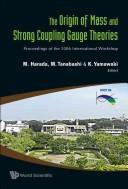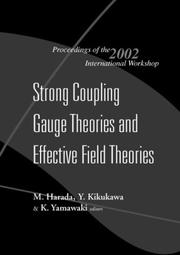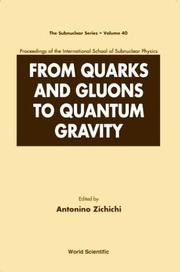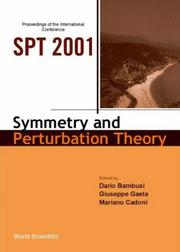| Listing 1 - 10 of 75 | << page >> |
Sort by
|
Book
ISBN: 981456625X 9789814566254 9789814566247 Year: 2014 Publisher: New Jersey : World Scientific,
Abstract | Keywords | Export | Availability | Bookmark
 Loading...
Loading...Choose an application
- Reference Manager
- EndNote
- RefWorks (Direct export to RefWorks)
This volume contains contributions which are largely focused on strong coupling gauge theories and the search of theories beyond the standard model, as well as new aspects in hot and dense QCD - particularly in view of the LHC experiments and the lattice studies of conformal fixed point. It contains, among others, many of the latest and important reports on walking technicolor and related subjects in the general context of conformality, discussions of phenomenological implications with the LHC, as well as the theoretical ones through lattice studies. Nonperturbative studies like lattice simula
Book
ISBN: 1283148633 9786613148636 9814329525 9789814329521 9789814329514 9814329517 Year: 2011 Publisher: Singapore Hackensack, NJ World Scientific
Abstract | Keywords | Export | Availability | Bookmark
 Loading...
Loading...Choose an application
- Reference Manager
- EndNote
- RefWorks (Direct export to RefWorks)
The purpose of the Workshop is to have intensive discussions on both theoretical and phenomenological aspects of strong coupling gauge theories (SCGTs), with particular emphasis on the model buildings to be tested in the LHC experiments. Dynamical issues are discussed in lattice simulations and various analytical methods. This proceedings volume is a collection of the presentations made at the Workshop by many leading scientists in the field.
Book
Year: 2018 Publisher: Basel, Switzerland : MDPI - Multidisciplinary Digital Publishing Institute,
Abstract | Keywords | Export | Availability | Bookmark
 Loading...
Loading...Choose an application
- Reference Manager
- EndNote
- RefWorks (Direct export to RefWorks)
Higher Spin Gauge Theories.

ISBN: 1281938378 9786611938376 9812790756 9789812790750 9812706410 9789812706416 9781281938374 6611938370 Year: 2008 Publisher: SG World Scientific
Abstract | Keywords | Export | Availability | Bookmark
 Loading...
Loading...Choose an application
- Reference Manager
- EndNote
- RefWorks (Direct export to RefWorks)
This volume includes discussion on new dynamical features in the light of (deconstruted/latticized) extra dimensions, holographic QCD, Moose/hidden local symmetry, and so on. New insights into the QCD as a prototype of strong coupling gauge theories as well as in its own right, particularly in hot and dense matter are included. Sample Chapter(s)
The String in an Excited Baryon (230 KB)
Contents:
- The String in an Excited Baryon (G 't Hooft)
- Mesons and Baryons from String Theory (S Sugimoto)
- Toy Model for Mixing of Two Chiral Nonets
Book
ISBN: 1009402099 1009402056 Year: 2023 Publisher: Cambridge : Cambridge University Press,
Abstract | Keywords | Export | Availability | Bookmark
 Loading...
Loading...Choose an application
- Reference Manager
- EndNote
- RefWorks (Direct export to RefWorks)
This 2002 book introduces the quantum theory of gauge fields. Emphasis is placed on four non-perturbative methods: path integrals, lattice gauge theories, the 1/N expansion, and reduced matrix models, all of which have important contemporary applications. Written as a textbook, it assumes a knowledge of quantum mechanics and elements of perturbation theory, while many relevant concepts are pedagogically introduced at a basic level in the first half of the book. The second half comprehensively covers large-N Yang-Mills theory. The book uses an approach to gauge theories based on path-dependent phase factors known as the Wilson loops, and contains problems with detailed solutions to aid understanding. Suitable for advanced graduate courses in quantum field theory, the book will also be of interest to researchers in high energy theory and condensed matter physics as a survey of recent developments in gauge theory.
Book
ISBN: 1282763687 9786612763687 9814304034 9789814304030 9789814304023 9814304026 Year: 2010 Publisher: Singapore Hackensack, NJ World Scientific
Abstract | Keywords | Export | Availability | Bookmark
 Loading...
Loading...Choose an application
- Reference Manager
- EndNote
- RefWorks (Direct export to RefWorks)
This volume contains the proceedings of the workshop Crossing the Boundaries: Gauge Dynamics at Strong Coupling, hosted by the William I. Fine Theoretical Physics Institute at the University of Minnesota, May 14 - 17, 2009. The workshop honored the 60th birthday of Professor Misha Shifman and his outstanding achievements in the field of gauge dynamics. The meeting attracted a fascinating group of researchers working on the cutting edge of dynamics of gauge theories, including supersymmetric and string theories. Their talks covered a wide area of recent developments in the field.

ISBN: 1281935557 9786611935559 981279512X 9789812795120 9781281935557 9789812384379 9812384375 9812384375 Year: 2003 Publisher: River Edge, N.J. World Scientific
Abstract | Keywords | Export | Availability | Bookmark
 Loading...
Loading...Choose an application
- Reference Manager
- EndNote
- RefWorks (Direct export to RefWorks)
This volume presents the important recent progress in both theoretical and phenomenological issues of strong coupling gauge theories, with/without supersymmetry and extra dimensions, etc. Emphasis is placed on dynamical symmetry breaking with large anomalous dimensions governed by the dynamics near the nontrivial fixed point. Also presented are recent developments of the corresponding effective field theories, such as those including light spectra other than the Nambu-Goldstone particles. This book is a must for all those who are interested in dynamical symmetry breaking and effective field

ISBN: 128195604X 9786611956042 9812796657 9789812796653 9789812386137 9812386130 Year: 2003 Publisher: River Edge, NJ World Scientific
Abstract | Keywords | Export | Availability | Bookmark
 Loading...
Loading...Choose an application
- Reference Manager
- EndNote
- RefWorks (Direct export to RefWorks)
In August/September 2002, a group of 78 physicists from 50 laboratories in 17 countries met in Erice, Italy, to participate in the 40th Course of the International School of Subnuclear Physics. The purpose of the School was to focus attention on the theoretical and phenomenological developments in gauge theories, as well as in all the other sectors of subnuclear physics. Experimental highights from the most relevant sources of new data were presented and discussed, including the latest news on theoretical developments in quantizing the gravitational forces. This volume constitutes the procee
Quantum gravity --- Gluons --- Quarks --- Gauge fields (Physics)

ISBN: 9789812778253 981277825X 9810247931 9789810247935 981024794X 9789810247942 1281929921 9786611929923 Year: 2001 Publisher: River Edge, NJ World Scientific
Abstract | Keywords | Export | Availability | Bookmark
 Loading...
Loading...Choose an application
- Reference Manager
- EndNote
- RefWorks (Direct export to RefWorks)
In August/September 2000, a group of 80 physicists from 53 laboratories in 15 countries met in Erice, Italy, to participate in the 38th Course of the International School of Subnuclear Physics. This book constitutes the proceedings of that meeting. It focuses on the theoretical investigation of several basic unity issues, including: (1) the understanding of gauge theories in both their continuum and lattice versions; (2) the possible existence and relevance of large extra dimensions together with the resultant lowering of the Planck/string scale to the TeV range; (3) the origin and structure o
Particles (Nuclear Physics) --- Gauge Fields (Physics) --- Science --- Gauge fields (Physics) --- Particles (Nuclear physics)
Book
ISBN: 1009402412 1009402447 Year: 2023 Publisher: Cambridge : Cambridge University Press,
Abstract | Keywords | Export | Availability | Bookmark
 Loading...
Loading...Choose an application
- Reference Manager
- EndNote
- RefWorks (Direct export to RefWorks)
Non-Abelian gauge theories, such as quantum chromodynamics (QCD) or electroweak theory, are best studied with the aid of Green's functions that are gauge-invariant off-shell, but unlike for the photon in quantum electrodynamics, conventional graphical constructions fail. The pinch technique provides a systematic framework for constructing such Green's functions, and has many useful applications. Beginning with elementary one-loop examples, this book goes on to extend the method to all orders, showing that the pinch technique is equivalent to calculations in the background field Feynman gauge. The Schwinger-Dyson equations are derived within the pinch technique framework, and are used to show how a dynamical gluon mass arises in QCD. Finally the volume turns to its many applications. This book is ideal for elementary particle theorists and graduate students. This 2011 title has been reissued as an Open Access publication on Cambridge Core.
Gauge fields (Physics) --- Non-Abelian groups. --- Green's functions.
| Listing 1 - 10 of 75 | << page >> |
Sort by
|

 Search
Search Feedback
Feedback About UniCat
About UniCat  Help
Help News
News